The Plant Kingdom British Flora
Plant Kingdom - British Plant Kingdom

This is Aristolochia grandiflora, one of the largest flowers in the world. It has the dual functions of the giant flower attracting flies with its stench and the orchid's forced pollination with its secret passages. Aristolochia grandiflora grows in the Caribbean and is a deciduous vine with flowers that can be up to 60 cm long. These huge and strange flowers can release a strong stench to attract flies. The inverted hairs in the corolla can only move forward and not backward, and carry the pollen on their bodies to the pistil at the deepest part of the flower; then the stigma ages, the stamens mature, and the flies lick the honey while rolling the pollen; the next morning the hairs shrink and the flies fly out to find the next flower. I have introduced plants of the Aristolochiaceae family before, so take a look.

Before appreciating the Victoria amazonica, you need to remind yourself: it is a plant of the Nymphaeales order, and is less related to the lotus of the Proteaceae order than wheat and sycamore trees. The Victoria genus has two existing species, Amazon Victoria and Cruz Victoria. It is native to Brazil. The genus name "Victoria" comes from the royal honor when it was opened in London, England in the 19th century. It is famous for its extremely large water lily leaves, which can reach a diameter of 3 meters. The edges are sharply bent upwards and have obvious deep cracks, which are the hallmark characteristics that distinguish it from lotus. These leaves are thin and fragile, and a straw can penetrate them; but they are quite load-bearing and can hold up a 30-kilogram child - the delicate mechanical structure of the veins on the back is one of the main reasons, which gave architects many inspirations to build vaults, such as the Crystal Palace back then.

The smallest water lily in the world is also the most precious plant in the world, the Rwandan water lily. The Rwandan water lily (Nymphaea thermarum) has a leaf diameter of only two or three centimeters, and the diameter of the small white flowers is only about two centimeters. The two water lilies that compare with it are the "Lightning Blue" in Kew Garden and the world's largest water lily Victoria. Originally grown in a freshwater hot spring in Rwanda, but for the poor locals, there was no reason to consider a plant extinct, so they drained the pond for irrigation in 2008 and the plant has disappeared from the wild ever since. Fortunately, the Royal Botanic Gardens, Kew, collected and bred it, but one was stolen in January this year.

These plants, commonly known as "green arrows" or "silver arrows", are five species of Argyroxiphium in the Asteraceae family. They mainly grow in solidified lava flows in volcanic areas above 1,500 meters in Hawaii, and occasionally appear in open woodlands. They are well adapted to nutrient-poor soils, and their conical, fleshy leaves are covered with velvety and waxy, which look silvery and effectively avoid excessive sunlight. But they grow very slowly, taking about 20 years to bloom, and to ensure successful pollination, all these wine-red to yellow chrysanthemums bloom together in just a few days. In addition, these plants and several related genera are classified as a "Silver Arrow Alliance", all of which are plants that look like silver arrows on the island of Hawaii.
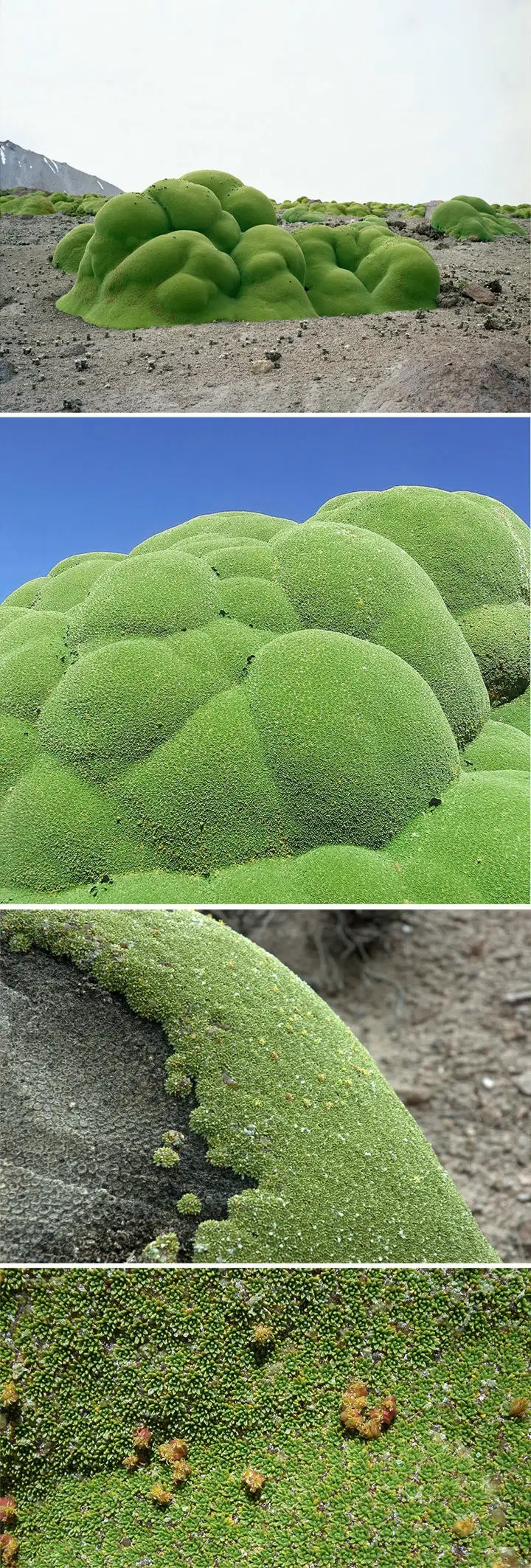
This is the densest shrub in the world, like a big rock covered with a green blanket. It is called "Yareta", which is transliterated as Yalta. Its scientific name is Azorella compacta. It grows in the Andes Mountains at an altitude of more than 4,000 meters. It is a plant of the Umbelliferae family and is closely related to celery, but the cold alpine climate forces them to grow extremely densely in order to retain the little heat from the sun. They can only grow half an inch a year. You can imagine how difficult it is to grow so big - in fact, they are 3,000 years old and are one of the oldest organisms on earth. Such a dense structure also brings disaster to them - it is difficult to find firewood for heating in the mountains, and even the conservators who take care of them think so.
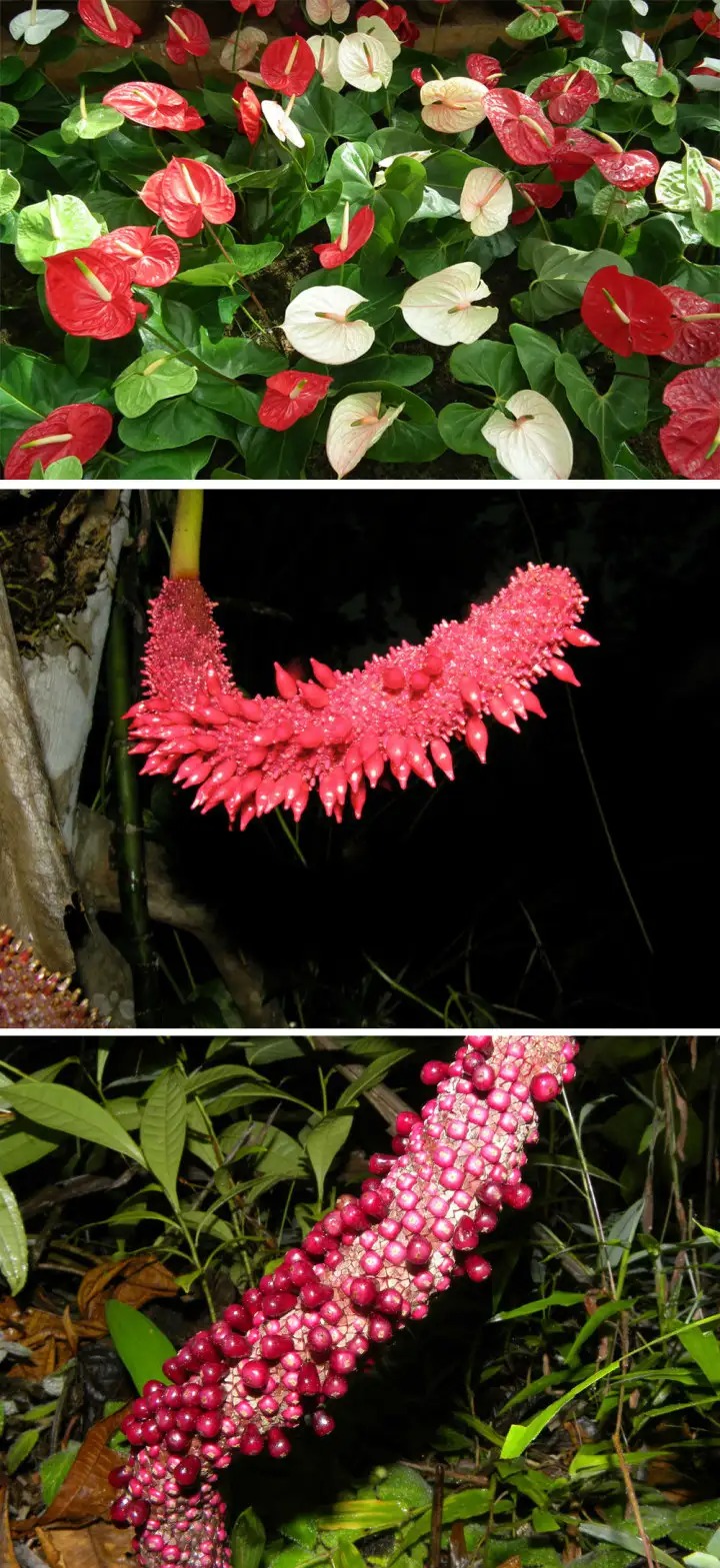
Anthurium andraeanum, also known as red anthurium, flower candle, and anthurium, is an ornamental flower that the people have loved very much in recent years. The bright spathe and delicate spike inflorescence are very unique. But the plants of the same genus as Anthurium are different. Anthurium is the largest genus in the Araceae family, with more than 1,000 species, many of which look ferocious and vicious, such as the second "Anthurium hacumense" and the third "Anthurium clavigerum". In addition, all plants of this genus, including Anthurium, cannot be eaten. They are rich in calcium oxalate needle-shaped crystals that can pierce the mouth, and have proteolytic enzymes that can cause severe inflammation.

What lovely big leaves, like umbrellas - this vegetable called "Akita fuciformis" is actually the leaf umbrella in the hand of the chinchilla! Akita fuciformis is a Japanese variant of the Asteraceae plant Petasites japonicus, also known as sweet butterbur. After blooming in early spring, it grows parasol-like leaves and can be two or three meters tall. They are huge because they are a natural polyploid plant - plant mitosis is easily interrupted by ultraviolet rays and cold to form polyploidy, and more chromosomes make the plant grow exceptionally large. Unlike animals, plants can reproduce asexually and mate with themselves, and can easily form stable polyploid populations and eventually species, so that more than half of all plants are polyploid.

At first glance, it looks like a coin growing in the grass. This is actually a thin film left after the silique of the silver fan grass cracks open. It is about 3 cm in diameter and looks silvery and really looks like money. Silver fan grass (Lunaria annua) is a plant of the genus Lunaria in the cruciferous family. It blooms bright purple flowers in spring and summer, and then produces a silique. The fruit structure is the same as that of rapeseed in the same family, but it grows into a round shape. When it is fully mature, it will crack open to release seeds. After drying, its unique appearance is often used as a decorative dried flower.

The cute and lovely Aquilegia annua, like a little beauty who likes to dress sweetly, is secretly vicious and hurtful. Plants of the genus Aquilegia in the family Ranunculaceae are distributed throughout the northern hemisphere. They are tough and long-lasting, and they bloom in summer with such unique flowers: 5 bright calyxes surround 5 light-colored funnel-shaped petals. The deeper the petals are, the darker the color is. There is a lot of nectar hidden in them. Butterflies and hummingbirds explore them under the dual guidance of vision and smell to assist in pollination. Interestingly, although the depth of the petal funnel varies greatly among species, it is determined by the length of the cells rather than the number. This is regarded as a classic case of evolution - tiny cell mutations are enough to form different species. However, this beautiful flower is a close relative of Aconitum and Cimicifuga foetida. The whole plant is highly poisonous. It tastes a bit sweet when eaten, but it will soon cause gastrointestinal inflammation and heart paralysis.
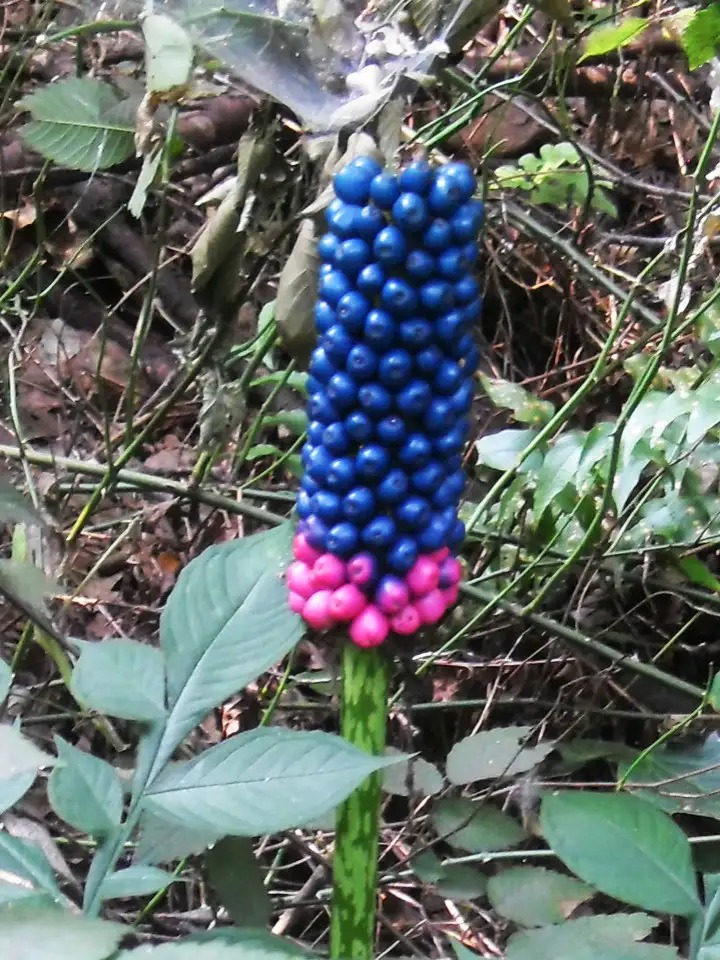
The fruit of a certain konjac, produced in Nanjing. Whose album is it from? Claim it.
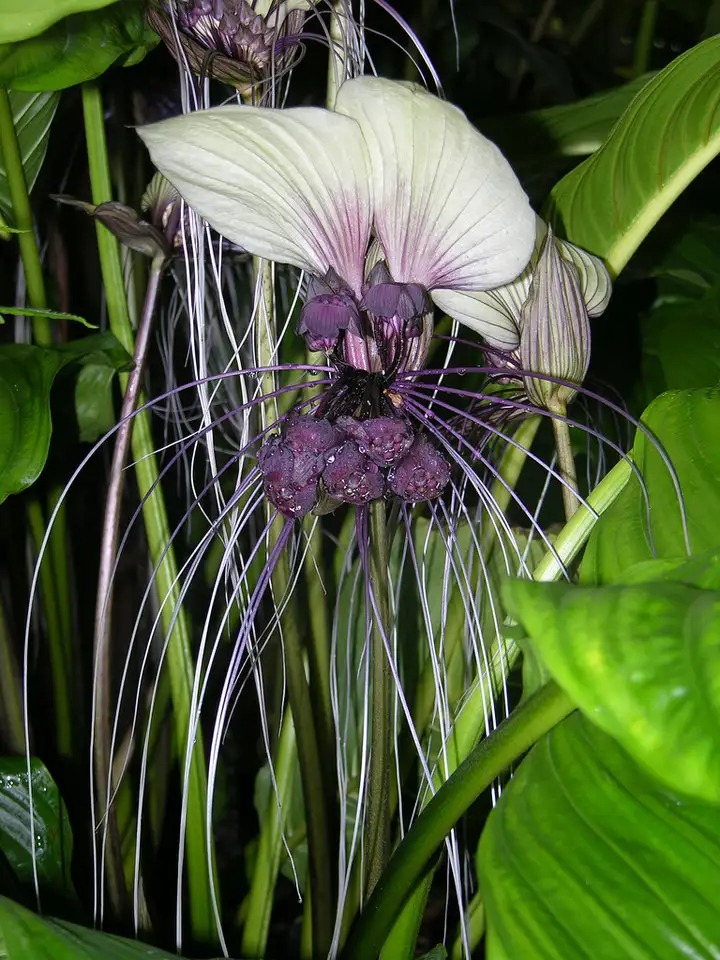
This strange-looking thing is the flower of the konjac potato. Konjac is distributed in tropical Asia, Africa, the eastern Pacific Ocean, Taiwan Island, etc. It grows in areas with an altitude of 1,100 meters and has not yet been artificially introduced for cultivation. Note that konjac and konjac are not the same thing. Konjac is a plant of the genus Amorphophallus, located in the Dioscoreaceae family of the Dioscoreales order; konjac is a plant of the genus Amorphophallus, located in the Araceae family of the Alismatales order.
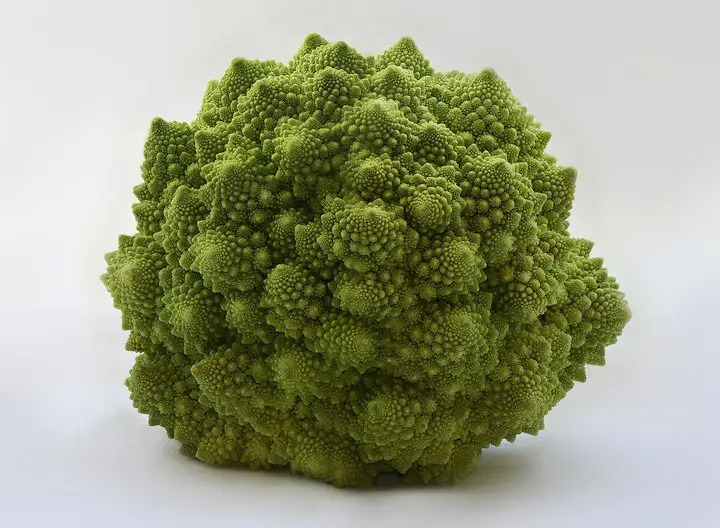
Cauliflower is one of the best examples of mathematical forms in nature. It embodies beautiful mathematical forms such as the golden section, fractals, and spirals. In addition, cauliflower, cabbage, cabbage, mustard tuber, rapeseed for eating and rapeseed for oil extraction are the products of plant domestication.
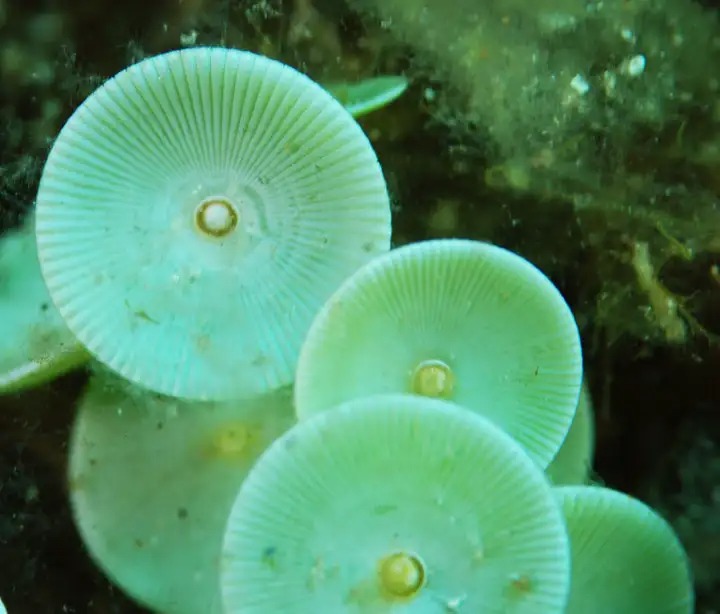
This jade disc looks like a mushroom, but it is very distantly related to fungi. It is one of the earliest plants, the Acetabularia. Like slime mold, the entire plant has only one cell. It only produces many spores when it reproduces, but it can stand several centimeters tall and perform all physiological functions. It is the most complex cell on earth. What's more amazing is that such a large cell has only one nucleus. Acetabularia is easy to graft. It is the grafting experiment on them that proves that the nucleus is the control center of the cell. It and the previous one are among the largest single-cell structures in the world.
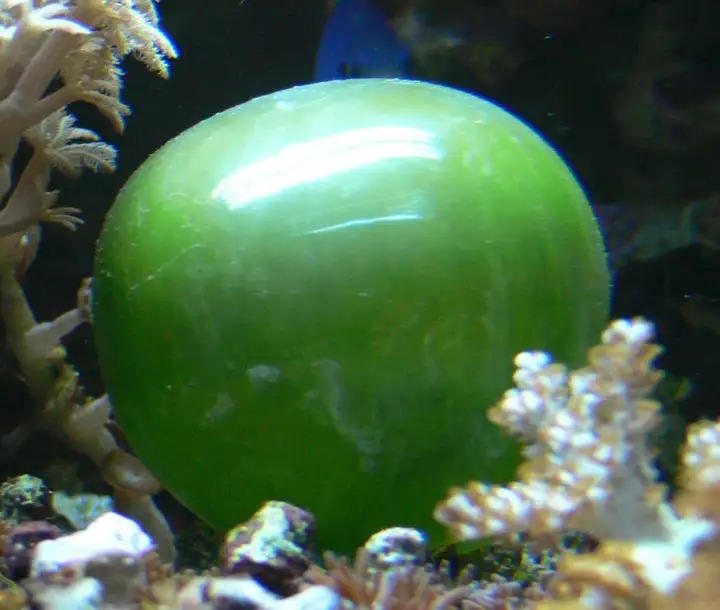
Ventricaria ventricosa is nearly spherical and filled with liquid. This algae does not branch and exists alone in a spherical form. Each spherical bubble can be attached to the substrate. It is a single-cell structure with a diameter of up to 2 inches. The spherical surface has a strange luster, especially underwater, which can even cover its dark green color. Its luster comes from the optical effect of the parallel arrangement of fibers on the surface of the spherical structure, similar to the structure of crystal. The toughness, smoothness and huge size of the spherical structure make many herbivores helpless. They are distributed between the Indian Ocean and the Pacific Ocean, from the winter solstice to Samoa, south to Australia, and throughout the Caribbean region. Their biggest feature is that they can tolerate extremely weak light.
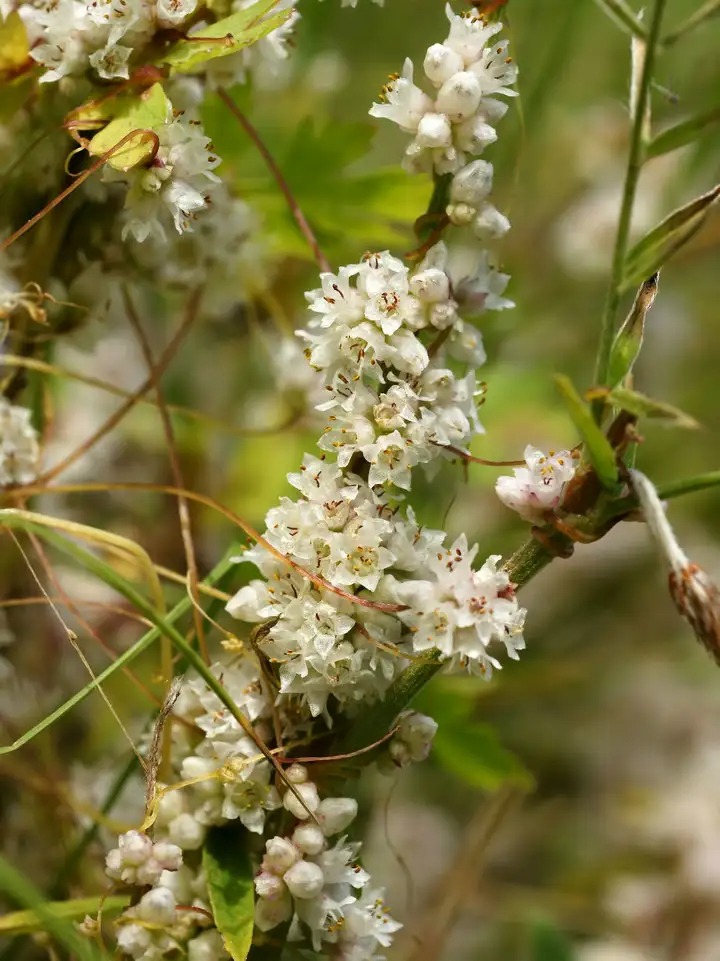
Cuscuta europaea is in bloom. Cuscuta is well-known in literature, but most people in cities today don't have a chance to see it. It is one of the few plants that can threaten crops like an insect plague. It is a plant of the family Convolvulaceae in the order Solanales. It has no chloroplasts, no roots at all, and its leaves have degenerated into useless tiny scales, but it can smell the scent of other plants, and then use its earthworm-like stems - the yellow filaments in the picture - to tightly wrap around the victim plant, extend its false roots and drill into the host's stems and leaves to absorb nutrients. It is a completely parasitic plant, and its tiny seeds can survive in the soil for up to 5 years. It is not very picky about food, and a dodder can parasitize several different plants at the same time.
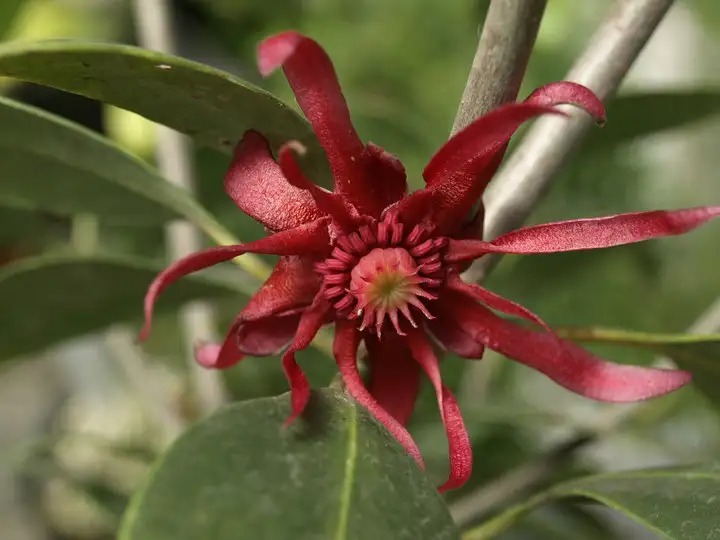
Illicium floridanum, a Caribbean star anise, is in bloom. Very strange. Star anise is a plant of the order Magnolias. The star anise comes from the south and can be used as a seasoning.
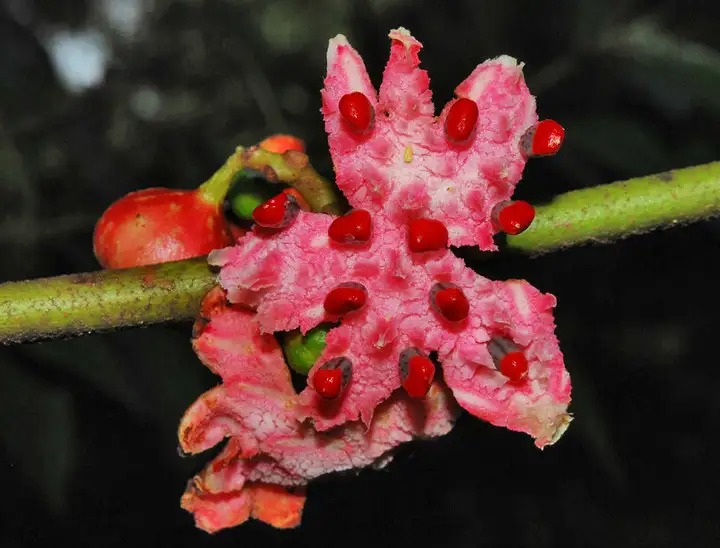
Siparuna sp. (Siparunaceae), the jar flower, blooms when the fruit is ripe. This is a plant of the order Ampelopsales. With the advancement of molecular biology and DNA technology, biological classification has changed a lot. For example, the dicots of the past have been dissolved into several different branches, rather than a general class, and some of them have been extracted to form "true dicots". Ampelopsales is an independent order outside of the true dicots and monocots, and is the most basal group of flowering plants.

Liverworts - Bryophytes are not a phylum either. There are three phyla: hornworts, liverworts, and mosses. Liverworts are very easy to attach to wet surfaces such as wood, and when they reproduce, they will grow a small cup and a small claw. Many people confuse liverworts with lichens, which are symbiotic fungi and algae without obvious plant structures.
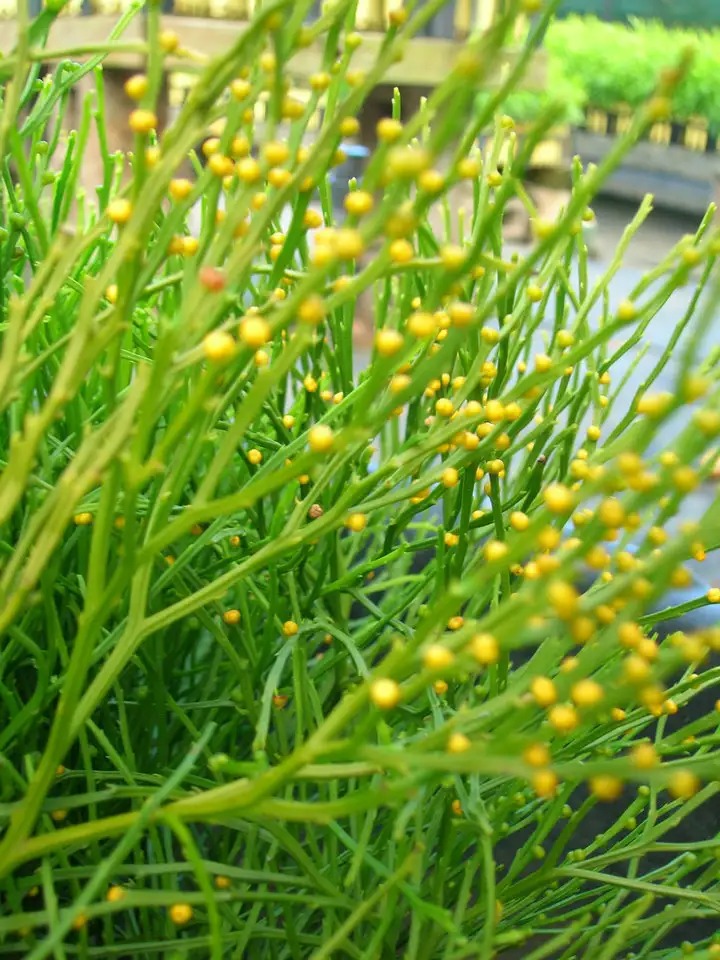
A close-up of Psilotum nudum. This fern is a vascular plant and lacks leaves but has a small protrusion instead. This small protrusion is not considered a true leaf because the vascular bundle is just below it, not inside it like a leaf. Pine fern genus also do not have true roots, they use rhizoids to hold onto the ground, and absorb with the help of symbiotic fungi called mycorrhiza. They belong to the phylum Psilotophyta, another phylum of ferns.
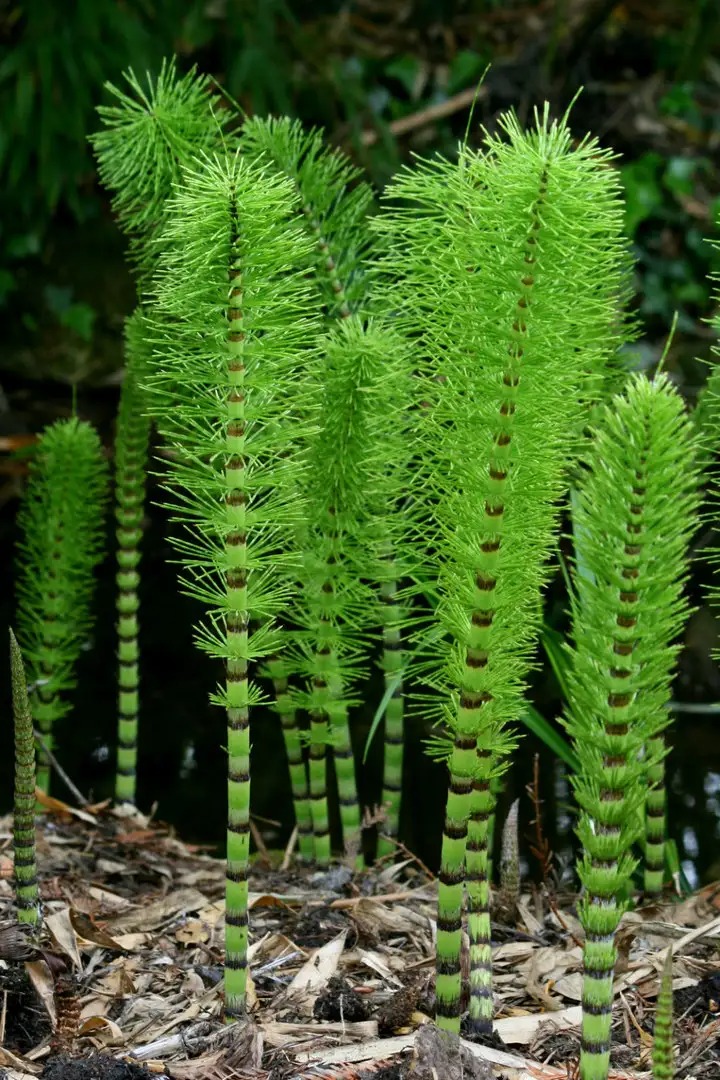
Horsetail, Equisetopsida - Horsetails are distributed all over the world. They used to be tall plants, but now they are all grasses, called horsetails. Most are 0.2 to 1.5 meters tall, but marsh horsetails can reach 2.5 meters tall, and giant horsetails in tropical America can reach 5 meters tall, and Mexican horsetails can reach 8 meters tall. The ferns usually mentioned are not a phylum like angiosperms, which includes about four phyla. Among them, horsetail is an arthropod phylum - there is only one genus in the whole phylum.
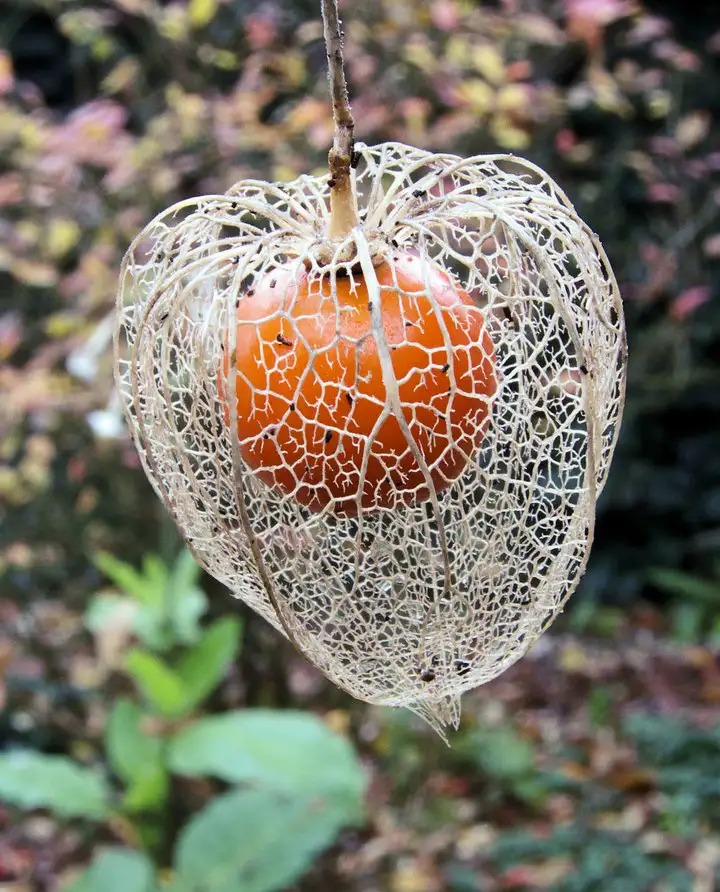
The first three Solanaceae plants are poisonous, but there are also cute and delicious ones. This fruit is called "Guniang", often misunderstood as "Girl", and its scientific name is Physalis, a genus under the Solanaceae family, distributed in temperate and subtropical regions around the world. This genus is characterized by a small tomato-like fruit enclosed in a large papery outer skin formed by the calyx. The one in the picture is Physalis alkekengi, and the lantern is hollow.
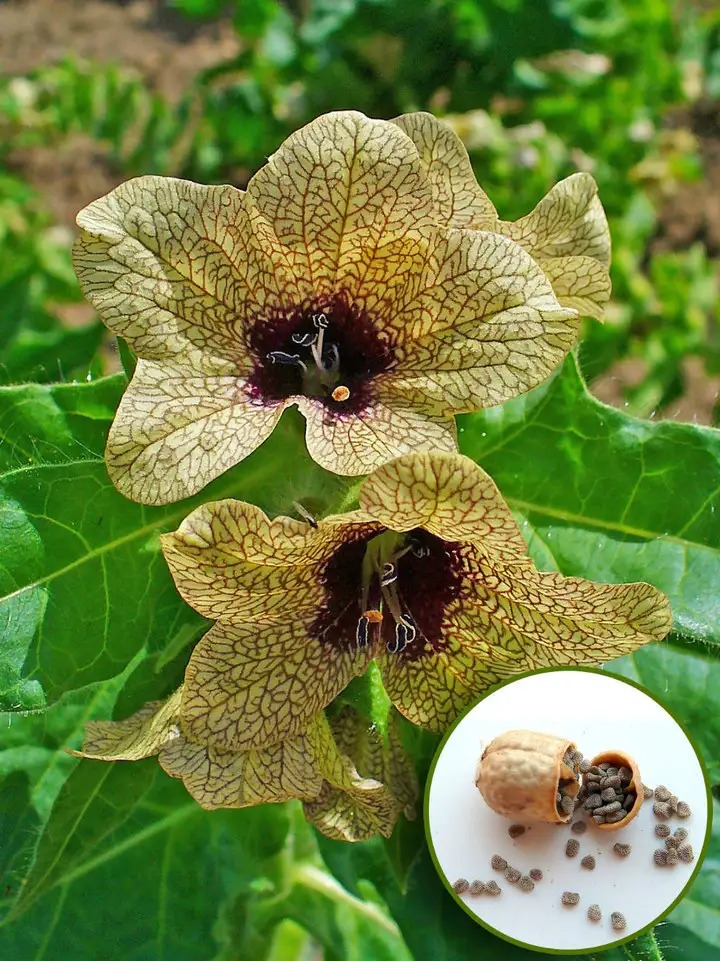
Hyoscyamus niger, another highly toxic plant of the Solanaceae family, and another highly toxic Chinese medicine. It is usually called "Tianxianzi", also known as Phyvos. It is rich in scopolamine and atropine, which is a very effective neuroreceptor blocker. A sufficient dose can cause anxiety, delirium, convulsions, coma and even death, but it can relieve organophosphorus poisoning. Their flowers are in a large bunch, look scary, and have a special odor.
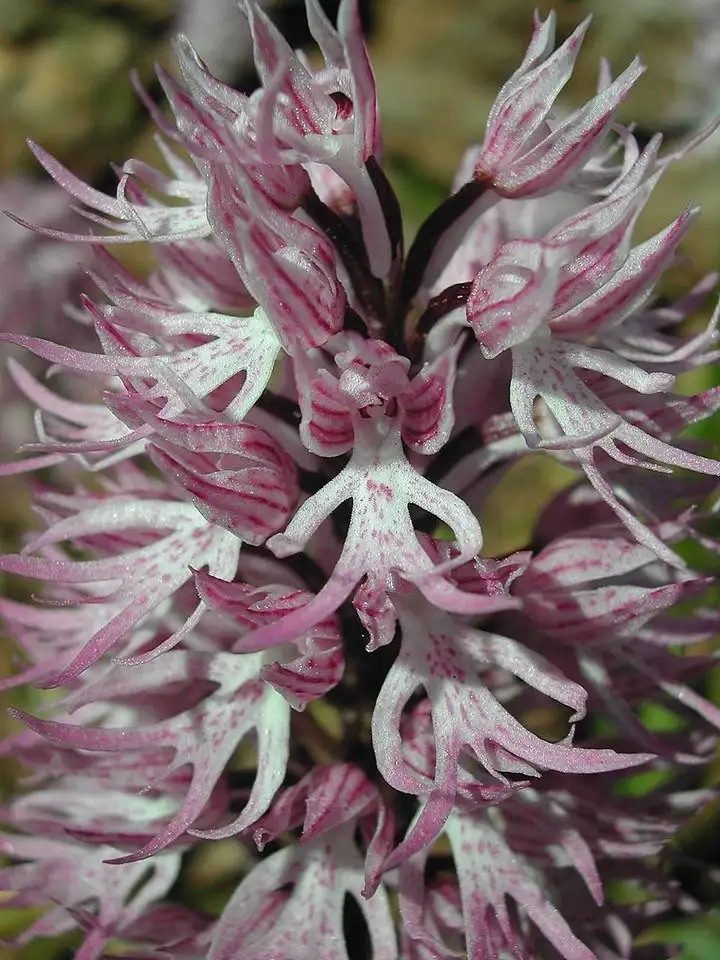
Italian Red Gate Orchid (scientific name: Orchis italica) is also called Italian Man Orchid, Pyramid Monkey Orchid, Testicle Orchid... Maru Orchid... Orchid... Orchid...
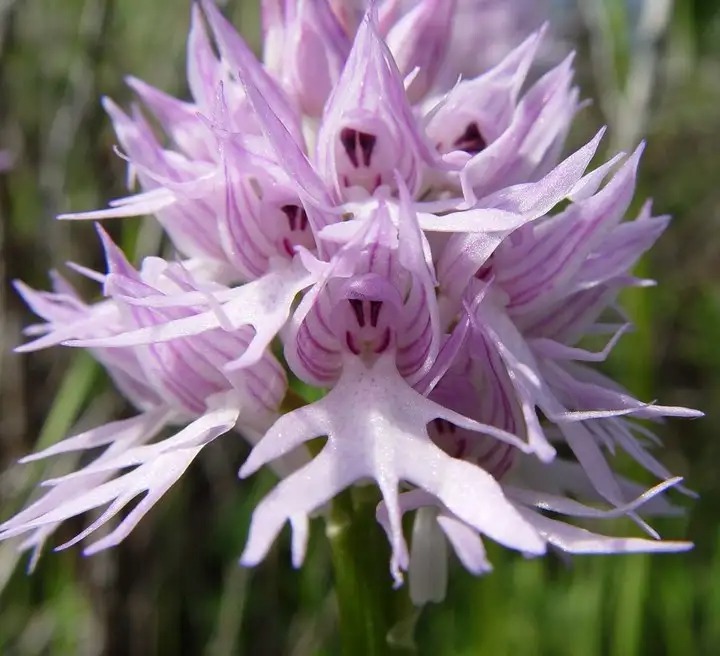
The tepals are helmet-shaped with dark stripes, and the whole flower resembles a human figure wearing a helmet. It is native to the Mediterranean region - it feels like a spirit.
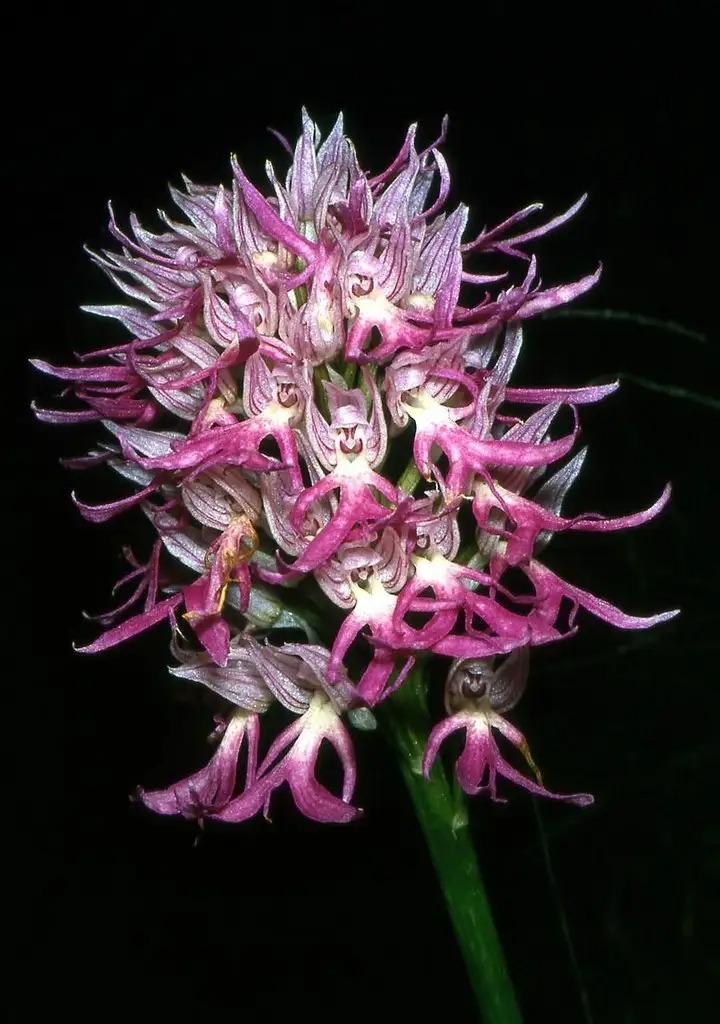
The plant of Italian red gate orchid is 20 to 50 cm tall, and the flowers are terminal, whitish pink or purple.
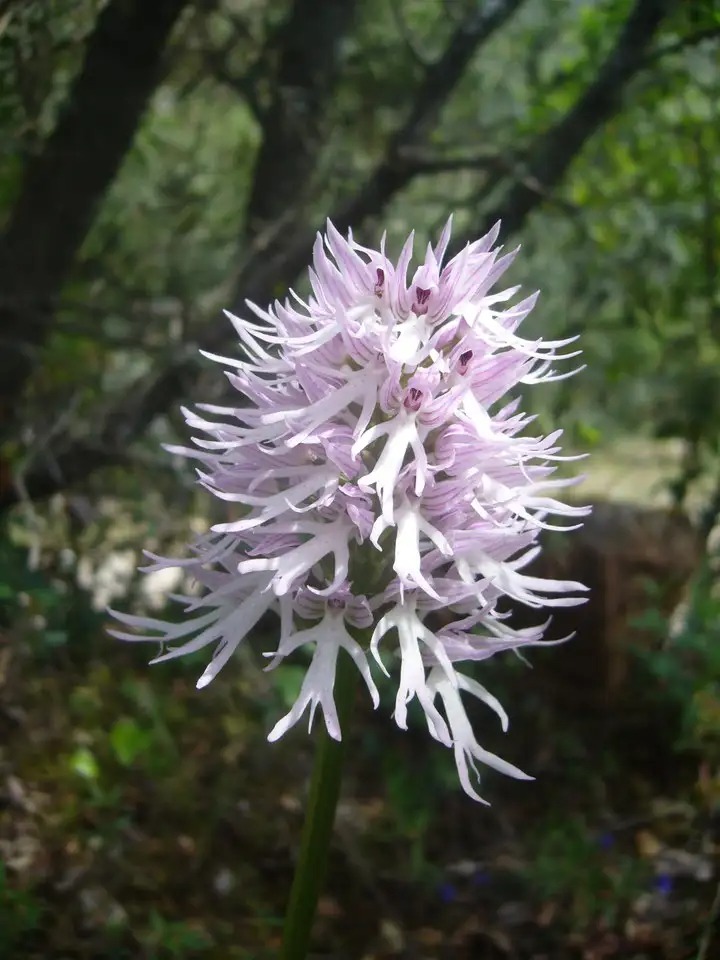
I saw someone asking about this on Guoke, so I checked it out. This orchid is called Italian red gate orchid, Orchis italica, native to the Mediterranean, and is a species of the genus Orchis in the family Orchidaceae.
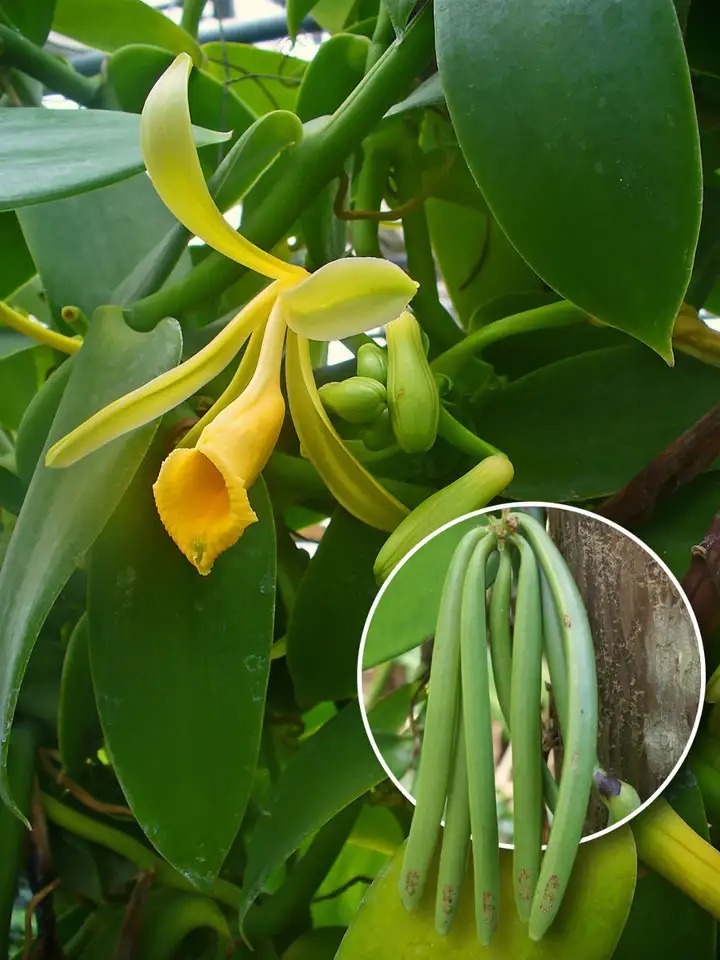
Have you ever eaten desserts with vanilla flavor? This is vanilla, scientifically known as Vanilla planifolia, which produces vanilla pods, and compounds that can be used to extract vanilla essence. Fresh pods have no fragrance and need to be processed through processes such as withering, fermentation, drying, and aging before they can emit a strong aroma. Fresh pods are harvested in November and can only be put on the market in May of the following year. Before 1841, Mexico was the only place in the world where vanilla was grown, because vanilla needed a specific bee, Melipona, to pollinate. In 1841, a 12-year-old slave in Madagascar invented a method of artificial pollination. Now, Madagascar is the world's largest producer of vanilla. The vanilla flavor of general food comes from artificial synthesis.
Landscaping

This is Aristolochia grandiflora, one of the largest flowers in the world. It has the dual functions of the giant flower attracting flies with its stench and the orchid's forced pollination with its secret passages. Aristolochia grandiflora grows in the Caribbean and is a deciduous vine with flowers that can be up to 60 cm long. These huge and strange flowers can release a strong stench to attract flies. The inverted hairs in the corolla can only move forward and not backward, and carry the pollen on their bodies to the pistil at the deepest part of the flower; then the stigma ages, the stamens mature, and the flies lick the honey while rolling the pollen; the next morning the hairs shrink and the flies fly out to find the next flower. I have introduced plants of the Aristolochiaceae family before, so take a look.

Before appreciating the Victoria amazonica, you need to remind yourself: it is a plant of the Nymphaeales order, and is less related to the lotus of the Proteaceae order than wheat and sycamore trees. The Victoria genus has two existing species, Amazon Victoria and Cruz Victoria. It is native to Brazil. The genus name "Victoria" comes from the royal honor when it was opened in London, England in the 19th century. It is famous for its extremely large water lily leaves, which can reach a diameter of 3 meters. The edges are sharply bent upwards and have obvious deep cracks, which are the hallmark characteristics that distinguish it from lotus. These leaves are thin and fragile, and a straw can penetrate them; but they are quite load-bearing and can hold up a 30-kilogram child - the delicate mechanical structure of the veins on the back is one of the main reasons, which gave architects many inspirations to build vaults, such as the Crystal Palace back then.

The smallest water lily in the world is also the most precious plant in the world, the Rwandan water lily. The Rwandan water lily (Nymphaea thermarum) has a leaf diameter of only two or three centimeters, and the diameter of the small white flowers is only about two centimeters. The two water lilies that compare with it are the "Lightning Blue" in Kew Garden and the world's largest water lily Victoria. Originally grown in a freshwater hot spring in Rwanda, but for the poor locals, there was no reason to consider a plant extinct, so they drained the pond for irrigation in 2008 and the plant has disappeared from the wild ever since. Fortunately, the Royal Botanic Gardens, Kew, collected and bred it, but one was stolen in January this year.

These plants, commonly known as "green arrows" or "silver arrows", are five species of Argyroxiphium in the Asteraceae family. They mainly grow in solidified lava flows in volcanic areas above 1,500 meters in Hawaii, and occasionally appear in open woodlands. They are well adapted to nutrient-poor soils, and their conical, fleshy leaves are covered with velvety and waxy, which look silvery and effectively avoid excessive sunlight. But they grow very slowly, taking about 20 years to bloom, and to ensure successful pollination, all these wine-red to yellow chrysanthemums bloom together in just a few days. In addition, these plants and several related genera are classified as a "Silver Arrow Alliance", all of which are plants that look like silver arrows on the island of Hawaii.

This is the densest shrub in the world, like a big rock covered with a green blanket. It is called "Yareta", which is transliterated as Yalta. Its scientific name is Azorella compacta. It grows in the Andes Mountains at an altitude of more than 4,000 meters. It is a plant of the Umbelliferae family and is closely related to celery, but the cold alpine climate forces them to grow extremely densely in order to retain the little heat from the sun. They can only grow half an inch a year. You can imagine how difficult it is to grow so big - in fact, they are 3,000 years old and are one of the oldest organisms on earth. Such a dense structure also brings disaster to them - it is difficult to find firewood for heating in the mountains, and even the conservators who take care of them think so.

Anthurium andraeanum, also known as red anthurium, flower candle, and anthurium, is an ornamental flower that the people have loved very much in recent years. The bright spathe and delicate spike inflorescence are very unique. But the plants of the same genus as Anthurium are different. Anthurium is the largest genus in the Araceae family, with more than 1,000 species, many of which look ferocious and vicious, such as the second "Anthurium hacumense" and the third "Anthurium clavigerum". In addition, all plants of this genus, including Anthurium, cannot be eaten. They are rich in calcium oxalate needle-shaped crystals that can pierce the mouth, and have proteolytic enzymes that can cause severe inflammation.

What lovely big leaves, like umbrellas - this vegetable called "Akita fuciformis" is actually the leaf umbrella in the hand of the chinchilla! Akita fuciformis is a Japanese variant of the Asteraceae plant Petasites japonicus, also known as sweet butterbur. After blooming in early spring, it grows parasol-like leaves and can be two or three meters tall. They are huge because they are a natural polyploid plant - plant mitosis is easily interrupted by ultraviolet rays and cold to form polyploidy, and more chromosomes make the plant grow exceptionally large. Unlike animals, plants can reproduce asexually and mate with themselves, and can easily form stable polyploid populations and eventually species, so that more than half of all plants are polyploid.

At first glance, it looks like a coin growing in the grass. This is actually a thin film left after the silique of the silver fan grass cracks open. It is about 3 cm in diameter and looks silvery and really looks like money. Silver fan grass (Lunaria annua) is a plant of the genus Lunaria in the cruciferous family. It blooms bright purple flowers in spring and summer, and then produces a silique. The fruit structure is the same as that of rapeseed in the same family, but it grows into a round shape. When it is fully mature, it will crack open to release seeds. After drying, its unique appearance is often used as a decorative dried flower.

The cute and lovely Aquilegia annua, like a little beauty who likes to dress sweetly, is secretly vicious and hurtful. Plants of the genus Aquilegia in the family Ranunculaceae are distributed throughout the northern hemisphere. They are tough and long-lasting, and they bloom in summer with such unique flowers: 5 bright calyxes surround 5 light-colored funnel-shaped petals. The deeper the petals are, the darker the color is. There is a lot of nectar hidden in them. Butterflies and hummingbirds explore them under the dual guidance of vision and smell to assist in pollination. Interestingly, although the depth of the petal funnel varies greatly among species, it is determined by the length of the cells rather than the number. This is regarded as a classic case of evolution - tiny cell mutations are enough to form different species. However, this beautiful flower is a close relative of Aconitum and Cimicifuga foetida. The whole plant is highly poisonous. It tastes a bit sweet when eaten, but it will soon cause gastrointestinal inflammation and heart paralysis.

The fruit of a certain konjac, produced in Nanjing. Whose album is it from? Claim it.

This strange-looking thing is the flower of the konjac potato. Konjac is distributed in tropical Asia, Africa, the eastern Pacific Ocean, Taiwan Island, etc. It grows in areas with an altitude of 1,100 meters and has not yet been artificially introduced for cultivation. Note that konjac and konjac are not the same thing. Konjac is a plant of the genus Amorphophallus, located in the Dioscoreaceae family of the Dioscoreales order; konjac is a plant of the genus Amorphophallus, located in the Araceae family of the Alismatales order.

Cauliflower is one of the best examples of mathematical forms in nature. It embodies beautiful mathematical forms such as the golden section, fractals, and spirals. In addition, cauliflower, cabbage, cabbage, mustard tuber, rapeseed for eating and rapeseed for oil extraction are the products of plant domestication.

This jade disc looks like a mushroom, but it is very distantly related to fungi. It is one of the earliest plants, the Acetabularia. Like slime mold, the entire plant has only one cell. It only produces many spores when it reproduces, but it can stand several centimeters tall and perform all physiological functions. It is the most complex cell on earth. What's more amazing is that such a large cell has only one nucleus. Acetabularia is easy to graft. It is the grafting experiment on them that proves that the nucleus is the control center of the cell. It and the previous one are among the largest single-cell structures in the world.

Ventricaria ventricosa is nearly spherical and filled with liquid. This algae does not branch and exists alone in a spherical form. Each spherical bubble can be attached to the substrate. It is a single-cell structure with a diameter of up to 2 inches. The spherical surface has a strange luster, especially underwater, which can even cover its dark green color. Its luster comes from the optical effect of the parallel arrangement of fibers on the surface of the spherical structure, similar to the structure of crystal. The toughness, smoothness and huge size of the spherical structure make many herbivores helpless. They are distributed between the Indian Ocean and the Pacific Ocean, from the winter solstice to Samoa, south to Australia, and throughout the Caribbean region. Their biggest feature is that they can tolerate extremely weak light.

Cuscuta europaea is in bloom. Cuscuta is well-known in literature, but most people in cities today don't have a chance to see it. It is one of the few plants that can threaten crops like an insect plague. It is a plant of the family Convolvulaceae in the order Solanales. It has no chloroplasts, no roots at all, and its leaves have degenerated into useless tiny scales, but it can smell the scent of other plants, and then use its earthworm-like stems - the yellow filaments in the picture - to tightly wrap around the victim plant, extend its false roots and drill into the host's stems and leaves to absorb nutrients. It is a completely parasitic plant, and its tiny seeds can survive in the soil for up to 5 years. It is not very picky about food, and a dodder can parasitize several different plants at the same time.

Illicium floridanum, a Caribbean star anise, is in bloom. Very strange. Star anise is a plant of the order Magnolias. The star anise comes from the south and can be used as a seasoning.

Siparuna sp. (Siparunaceae), the jar flower, blooms when the fruit is ripe. This is a plant of the order Ampelopsales. With the advancement of molecular biology and DNA technology, biological classification has changed a lot. For example, the dicots of the past have been dissolved into several different branches, rather than a general class, and some of them have been extracted to form "true dicots". Ampelopsales is an independent order outside of the true dicots and monocots, and is the most basal group of flowering plants.

Liverworts - Bryophytes are not a phylum either. There are three phyla: hornworts, liverworts, and mosses. Liverworts are very easy to attach to wet surfaces such as wood, and when they reproduce, they will grow a small cup and a small claw. Many people confuse liverworts with lichens, which are symbiotic fungi and algae without obvious plant structures.

A close-up of Psilotum nudum. This fern is a vascular plant and lacks leaves but has a small protrusion instead. This small protrusion is not considered a true leaf because the vascular bundle is just below it, not inside it like a leaf. Pine fern genus also do not have true roots, they use rhizoids to hold onto the ground, and absorb with the help of symbiotic fungi called mycorrhiza. They belong to the phylum Psilotophyta, another phylum of ferns.

Horsetail, Equisetopsida - Horsetails are distributed all over the world. They used to be tall plants, but now they are all grasses, called horsetails. Most are 0.2 to 1.5 meters tall, but marsh horsetails can reach 2.5 meters tall, and giant horsetails in tropical America can reach 5 meters tall, and Mexican horsetails can reach 8 meters tall. The ferns usually mentioned are not a phylum like angiosperms, which includes about four phyla. Among them, horsetail is an arthropod phylum - there is only one genus in the whole phylum.

The first three Solanaceae plants are poisonous, but there are also cute and delicious ones. This fruit is called "Guniang", often misunderstood as "Girl", and its scientific name is Physalis, a genus under the Solanaceae family, distributed in temperate and subtropical regions around the world. This genus is characterized by a small tomato-like fruit enclosed in a large papery outer skin formed by the calyx. The one in the picture is Physalis alkekengi, and the lantern is hollow.

Hyoscyamus niger, another highly toxic plant of the Solanaceae family, and another highly toxic Chinese medicine. It is usually called "Tianxianzi", also known as Phyvos. It is rich in scopolamine and atropine, which is a very effective neuroreceptor blocker. A sufficient dose can cause anxiety, delirium, convulsions, coma and even death, but it can relieve organophosphorus poisoning. Their flowers are in a large bunch, look scary, and have a special odor.

Italian Red Gate Orchid (scientific name: Orchis italica) is also called Italian Man Orchid, Pyramid Monkey Orchid, Testicle Orchid... Maru Orchid... Orchid... Orchid...

The tepals are helmet-shaped with dark stripes, and the whole flower resembles a human figure wearing a helmet. It is native to the Mediterranean region - it feels like a spirit.

The plant of Italian red gate orchid is 20 to 50 cm tall, and the flowers are terminal, whitish pink or purple.

I saw someone asking about this on Guoke, so I checked it out. This orchid is called Italian red gate orchid, Orchis italica, native to the Mediterranean, and is a species of the genus Orchis in the family Orchidaceae.

Have you ever eaten desserts with vanilla flavor? This is vanilla, scientifically known as Vanilla planifolia, which produces vanilla pods, and compounds that can be used to extract vanilla essence. Fresh pods have no fragrance and need to be processed through processes such as withering, fermentation, drying, and aging before they can emit a strong aroma. Fresh pods are harvested in November and can only be put on the market in May of the following year. Before 1841, Mexico was the only place in the world where vanilla was grown, because vanilla needed a specific bee, Melipona, to pollinate. In 1841, a 12-year-old slave in Madagascar invented a method of artificial pollination. Now, Madagascar is the world's largest producer of vanilla. The vanilla flavor of general food comes from artificial synthesis.